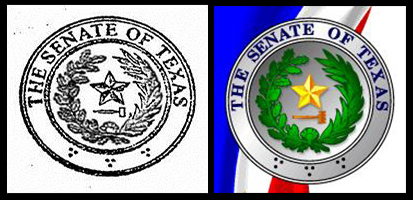One of the fun things about the Legislature is the history behind even the smallest details. In this post, we explore the history of the Texas Senate seal, which was adopted in 1977.
Official seals lend authenticity and are used in letterheads, publications, and a variety of other official documents. In the Texas Legislature, both the House and the Senate have their own seals, as do many state offices, departments, and political subdivisions. Often, these seals are slight variations of the State of Texas seal.
Prior to 1977, many Senate documents used a version of the State of Texas seal that included nine dots arranged in three groups of three (shown below left). This version of the state seal was commonly used in Senate Journals, appearing as late as 1983 and as early as 1931. It also appeared on many Senate interim committee reports. Other versions of the state seal were also used by the Senate; one version had three dots spaced equally across the bottom (below center), and another version had an ornamental border centered on a cross pattée (below right).

The Senate seal in use today was adopted in 1977 by SR 262, 65th RS by Senator Betty Andujar. The seal was to consist of "a star of five points above a gavel, both encircled by olive and live oak branches, and a border bearing the words 'The Senate of Texas'." Little information is available about how the design was developed, but, like many other agency seals, the Senate seal represents a slightly modified version of the State of Texas seal. A drawing of the seal from SR 262 is below, next to the Senate seal you see used today.

Did you know? Section 17.08 of the Texas Business and Commerce Code requires that a person must obtain a license to use the Texas State Seal for a commercial purpose. See the Secretary of State's website for more details.

